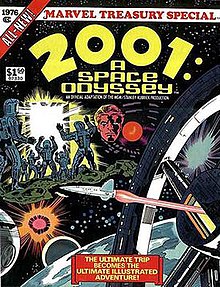2001: A Space Odyssey (comics)
| 2001: A Space Odyssey | |
|---|---|

2001: A Space Odyssey [Marvel Treasury Special] (1976)
|
|
| Publication information | |
| Publisher | Marvel Comics |
| Schedule | Monthly |
| Formats | Original material for the series has been published as a set of ongoing series and one-shot comics. |
| Genre | |
| Publication date |
Treasury 1976 Series December 1976–September 1977 |
| Number of issues |
Treasury 1 Series 10 |
| Creative team | |
| Writer(s) | Jack Kirby |
| Penciller(s) | Jack Kirby |
| Inker(s) |
List
|
| Letterer(s) |
List
|
| Colorist(s) |
List
|
| Editor(s) |
List
|
2001: A Space Odyssey was the name of an American oversized comic book adaptation of the 1968 film of the same name as well as a monthly series, lasting ten issues, which expanded upon the concepts presented in the Stanley Kubrick film and the novel by Arthur C. Clarke. Jack Kirby wrote and pencilled both the adaptation and the series, which were published by Marvel Comics beginning in 1976. The adaptation was part of the agreement of Kirby's return to Marvel.
Marvel published the adaptation in its then-common treasury edition format featuring tabloid-sized pages of roughly twice the size of a normal comic book. The story is a close adaptation of the events of the film, but differs in the fact that Kirby incorporated additional dialog from two other sources: the Clarke/Kubrick novel, and a copy of an earlier draft script of the film that included the more colloquial-sounding version of HAL 9000, as originally voiced by actor Martin Balsam before Douglas Rain took over. In addition, the comic narrative captions describe the characters' thoughts and feelings, a significantly different approach from that taken by the film.
The treasury edition also contained a 10-page article entitled "2001: A Space Legacy" written by David Anthony Kraft.
Shortly after the publication of the treasury edition, Kirby continued to explore the concepts of 2001 in a monthly comic book series of the same name, the first issue of which was dated December 1976. In this issue, Kirby followed the pattern established in the film. Once again the reader encounters a prehistoric man ("Beast-Killer") who gains new insight upon encountering a monolith as did Moon-Watcher in the film. The scene then shifts, where a descendant of Beast-Killer is part of a space mission to explore yet another monolith. When he finds it, this monolith begins to transform the astronaut into a star child, called in the comic a "New Seed".
...
Wikipedia
